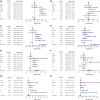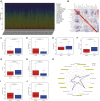A Novel Nine Apoptosis-Related Genes Signature Predicting Overall Survival for Kidney Renal Clear Cell Carcinoma and its Associations with Immune Infiltration
- PMID: 33748185
- PMCID: PMC7969794
- DOI: 10.3389/fmolb.2021.567730
A Novel Nine Apoptosis-Related Genes Signature Predicting Overall Survival for Kidney Renal Clear Cell Carcinoma and its Associations with Immune Infiltration
Abstract
Background: This study was designed to establish a sensitive prognostic model based on apoptosis-related genes to predict overall survival (OS) in patients with clear cell renal cell carcinoma (ccRCC). Methods: Obtaining the expression of apoptosis-related genes and associated clinical parameters from online datasets (The Cancer Genome Atlas, TCGA), their biological function analyses were performed through differently expressed genes. By means of LASSO, unadjusted and adjusted Cox regression analyses, this predictive signature was constructed and validated by internal and external databases (both TCGA and ArrayExpress). Results: A total of nine apoptosis-related genes (SLC27A2, TNFAIP2, IFI44, CSF2, IL4, MDK, DOCK8, WNT5A, APP) were ultimately screened as associated hub genes and utilized to construct a prognosis model. Then our constructed riskScore model significantly passed the validation in both the internal and external datasets of OS (all p < 0.05) and verified their expressions by qRT-PCR. Moreover, we conducted the Receiver Operating Characteristic (ROC), finding the area under the ROC curves (AUCs) were all above 0.70 which indicated that riskScore was a stable independent prognostic factor (p < 0.05). Furthermore, prognostic nomograms were established to figure out the relationship between 1-, 3- and 5-year OS and individual parameters for ccRCC patients. Additionally, survival analyses indicated that our riskScore worked well in predicting OS in subgroups of age, gender, grade, stage, T, M, N0, White (all p < 0.05), except for African, Asian and N1 (p > 0.05). We also explored its association with immune infiltration and applied cMap database to seek out highly correlated small molecule drugs. Conclusion: Our study successfully constructed a prognostic model containing nine hub apoptosis-related genes for ccRCC, helping clinicians predict patients' OS and making the prognostic assessment more standardized. Future prospective studies are required to validate our findings.
Keywords: apoptosis-related genes; clear cell renal cell carcinoma; overall survival; prognosis; signature.
Copyright © 2021 Wang, Chen, Zhu, Ma and Xing.
Conflict of interest statement
The authors declare that the research was conducted in the absence of any commercial or financial relationships that could be construed as a potential conflict of interest.
Figures










Similar articles
-
Six RNA binding proteins (RBPs) related prognostic model predicts overall survival for clear cell renal cell carcinoma and is associated with immune infiltration.Bosn J Basic Med Sci. 2022 Jun 1;22(3):435-452. doi: 10.17305/bjbms.2021.6097. Bosn J Basic Med Sci. 2022. PMID: 34420511 Free PMC article.
-
A novel 10 glycolysis-related genes signature could predict overall survival for clear cell renal cell carcinoma.BMC Cancer. 2021 Apr 9;21(1):381. doi: 10.1186/s12885-021-08111-0. BMC Cancer. 2021. PMID: 33836688 Free PMC article.
-
Decreased expression of METTL14 predicts poor prognosis and construction of a prognostic signature for clear cell renal cell carcinoma.Cancer Cell Int. 2021 Jan 11;21(1):46. doi: 10.1186/s12935-020-01738-2. Cancer Cell Int. 2021. PMID: 33430867 Free PMC article.
-
Construction and Validation of an Autophagy-Related Prognostic Risk Signature for Survival Predicting in Clear Cell Renal Cell Carcinoma Patients.Front Oncol. 2020 May 5;10:707. doi: 10.3389/fonc.2020.00707. eCollection 2020. Front Oncol. 2020. PMID: 32432045 Free PMC article.
-
Identification of small molecule drugs and development of a novel autophagy-related prognostic signature for kidney renal clear cell carcinoma.Cancer Med. 2020 Oct;9(19):7034-7051. doi: 10.1002/cam4.3367. Epub 2020 Aug 11. Cancer Med. 2020. PMID: 32780567 Free PMC article.
Cited by
-
Development of an Interferon Gamma Response-Related Signature for Prediction of Survival in Clear Cell Renal Cell Carcinoma.J Inflamm Res. 2021 Sep 27;14:4969-4985. doi: 10.2147/JIR.S334041. eCollection 2021. J Inflamm Res. 2021. PMID: 34611422 Free PMC article.
-
A Novel Machine Learning 13-Gene Signature: Improving Risk Analysis and Survival Prediction for Clear Cell Renal Cell Carcinoma Patients.Cancers (Basel). 2022 Apr 24;14(9):2111. doi: 10.3390/cancers14092111. Cancers (Basel). 2022. PMID: 35565241 Free PMC article.
-
Six RNA binding proteins (RBPs) related prognostic model predicts overall survival for clear cell renal cell carcinoma and is associated with immune infiltration.Bosn J Basic Med Sci. 2022 Jun 1;22(3):435-452. doi: 10.17305/bjbms.2021.6097. Bosn J Basic Med Sci. 2022. PMID: 34420511 Free PMC article.
-
Identifying tumour microenvironment-related signature that correlates with prognosis and immunotherapy response in breast cancer.Sci Data. 2023 Mar 3;10(1):119. doi: 10.1038/s41597-023-02032-2. Sci Data. 2023. PMID: 36869083 Free PMC article.
-
Identification and validation of a 9-RBPs-related gene signature associated with prognosis and immune infiltration in bladder cancer based on bioinformatics analysis and machine learning.Transl Androl Urol. 2025 Apr 30;14(4):1066-1081. doi: 10.21037/tau-2024-688. Epub 2025 Apr 27. Transl Androl Urol. 2025. PMID: 40376515 Free PMC article.
References
LinkOut - more resources
Full Text Sources
Other Literature Sources

